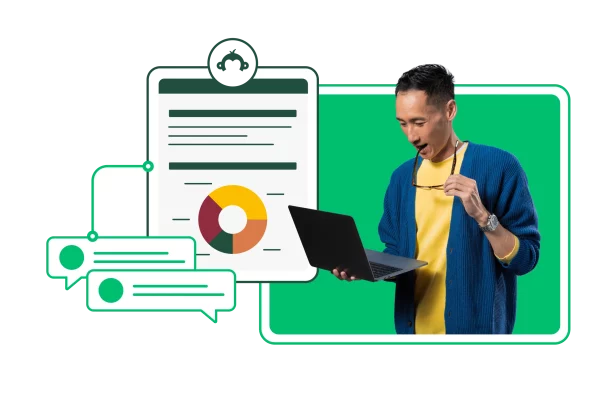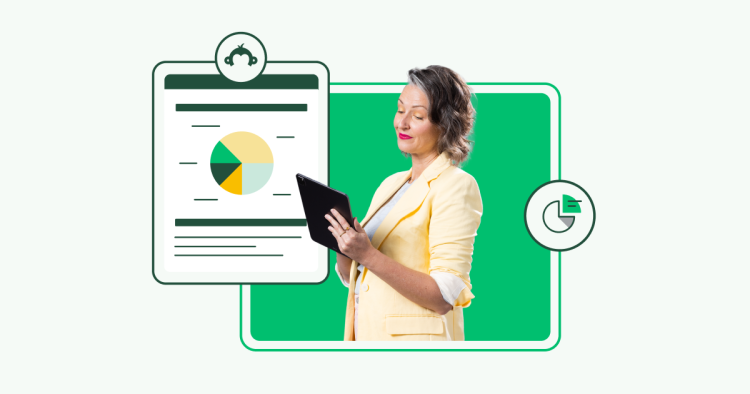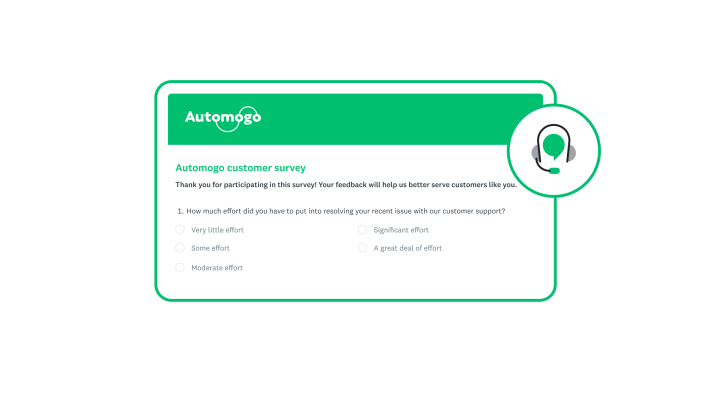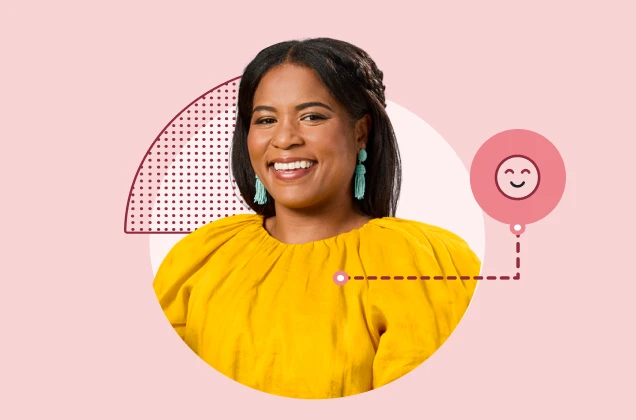Focus groups and surveys for customer and market research

Whether you’re looking for competitive insights or need to boost customer loyalty, one of your most valuable tools is customer feedback.
Why? Customer feedback helps you understand what you’re doing right, what you’re doing wrong, and gives you the information you need to make improvements. But there are different methods for collecting customer feedback. More specifically, you’ll need to choose between running focus groups vs. surveys.
To help you decide, here’s a guide to the pros and cons of focus groups and surveys—and when to use each for your customer insights.
What is a focus group?
When a researcher conducts a focus group, they carefully select a few people who represent a specific target market or user persona. During a focus group, the researcher asks questions and facilitates a discussion with group participants. Typically, focus groups are interactive, and you hold them in a neutral place where people feel comfortable telling you what they really think.
By definition, a focus group is designed to provide exploratory qualitative insights rather than conclusive quantitative research data. That’s because you’re not analyzing a large dataset. Instead, you’re listening to opinions, perspectives, and personal stories or anecdotes. This can give you a fuller picture of your customer experience or target market, but what you hear won’t give you conclusive evidence about the larger population you’re trying to reach.
That said, the data you get from a focus group can give you valuable insights into what your customers think and why they think the way they do. This research method can help you develop a product that aligns with your market, create engaging marketing campaigns, or respond to market shifts.
What is a survey?
Surveys are a research method used to collect feedback from a sample of people. They tend to be classified as quantitative research, and the results can be conclusive, unlike those of a focus group.
Surveys let you ask questions and measure just about anything. They can be as short as a single question or as long as several hundred questions. Answer formats include multiple-choice, rating scales, and open-ended questions.
Surveys offer great flexibility in terms of budget and timing. However, they can also be viewed as inflexible because once you start running a survey, you shouldn’t make too many changes. Your questions need to be consistent to collect accurate data.

Focus groups vs surveys—which should be used when?
Before you choose a focus group panel or survey, write down your research questions. Then ask more questions about those questions. In other words, think about the kind of information you’d need to conduct this research.
- Can you get satisfactory answers through one-way questions, or would it be better to have a conversation?
- Do you want to test a concept or user experience that may take more explanation?
- Do you want to observe participant reactions firsthand?
- Would you be comfortable making decisions based on a few opinions?
- Do you need feedback from a larger sample size for statistically significant results?
You can use a focus group to get closer to your customers or target market. Listen to what motivates them, delights them, or the problems or pain points they have. These insights could inform your new product or service, give you competitive insights, or strengthen your Voice of the Customer program.
Surveys are often tied to specific events, and you can analyze the data to make targeted, specific improvements to your organization. For example, you’d send a customer service feedback survey to any customer who interacted with your support team. The feedback you get could help you track key customer service metrics and make targeted improvements.

The pros and cons of focus groups and surveys
Still not sure whether to use a focus group or survey? Here’s a handy list to help you decide which you should use for your customer or market research.
Focus groups
Pros
- Hear customer feedback in your customers' own words.
- Discover ideas and pain points that your internal team may not have considered but are important to your customer.
- Have the flexibility to dive deeper into issues during the discussion.
- Ability to clarify customer feedback by asking specific follow-up questions.
Cons
- Expenses may include participant recruiting, facility rental, moderator and/or agency fees, compensation for participation, travel to multiple locations to view groups, and more.
- You could get skewed results due to outspoken participants who dominate group discussion.
- Have difficulty recruiting qualified participants due to the time commitment involved.
- Invest significant time and effort planning, organizing, recruiting, and (potentially) traveling.
Surveys
Pros
- Get feedback quickly. Depending on the number of respondents, you could receive results within 24-48 hours.
- Provide a way to design research once and then send and resend the same survey over time. (Plus, this makes it easy to benchmark and track results.)
- If your survey allows anonymous responses, participants may be more comfortable giving you candid feedback.
- Reach more than one type of customer simultaneously and then slice and dice the data based on any variable.
Cons
- For customer and market research, you might have trouble recruiting participants if you don’t have customer contact information.
- You can’t clarify customer feedback by asking follow-up questions.
- Participants may not have a way to proactively provide feedback on issues not included in the survey.
- You’re limited in what you can ask because survey length matters. People are less likely to give thoughtful, complete responses to longer surveys.
For both types of research, you’ll need to do similar preparation.
How to run a focus group or survey successfully
1. Set goals
Before you write your survey or conduct your focus group panel, you need to set a goal for your research. Your goal is what you need to do to move forward or make a decision.
By writing out your goal or goals (not too many!) you can hone your survey or focus group questions. In either case, your survey respondents and focus group participants will be grateful.
Plus, when you define your goals, you can ensure your research aligns with company goals or relevant KPIs. It’s also a good idea to collaborate with key internal stakeholders to ensure you’re asking questions that’ll provide truly useful information.
2. Recruit participants
Who do you want to take your survey or participate in your focus group? Equally important, who do you want to exclude?
Your participants are integral to the success of your research. So think about their demographics, including age, gender, household income, profession, and where they live.
Do you have their contact information, or do you need a research panel to help you survey your target market? Do you want respondents or participants to be familiar with your product or product category?
If you need help finding the right people to take your survey, SurveyMonkey Audience can get in touch with just about anybody, according to your specifications.
3. Develop a focus group discussion guide
The discussion guide is similar to a script for the moderator to use in focus groups. The discussion guide structures the conversation, paces the discussion, addresses the objectives, and engages all participants. Before you create a discussion guide, consider the following:
- What questions do you want the moderator to ask?
- What should the moderator know about your project to answer participants’ questions?
- If you’re testing a concept or prototype, what are the cues or hints a moderator can give to participants?
- What should the moderator know about your research goals so that they can ask the right follow-up questions?
If you’re working with a researcher, start with your focus group goals and objectives, which should align with your organization's goals. Collaborate with them to make sure you’re asking questions the right way and not overwhelming the group participants with too many topics or tasks.
4. Write good survey questions
If you’re creating a survey, follow these best practices for writing good survey questions and avoiding common survey mistakes:
- Avoid leading and loaded questions
- Don’t ask double-barreled questions
- Take care when asking sensitive survey questions
- Use clear, straightforward language
- Use the correct question type
Remember to stay focused. Your goal informs the questions you ask. Whether you’re creating a transactional vs. relational survey or balancing your number of closed-ended vs. open-ended questions, always keep your goal in mind.
If you still need help creating reliable surveys and questions, use our expert-written survey templates. Or check out SurveyMonkey Genius, our AI-powered survey expert that can take your prompt and write your whole survey.
5. Consider focus group participant preparation
For a fruitful focus group conversation, you should consider participant preparation. Preparation can establish expectations so participants are comfortable and confident participating in a group conversation.
Participant preparation may look like:
- Sharing the location, time, and duration of the focus group
- Informing participants of discussion topics
- Explaining any rules or policies, including any non-disclosure agreements
Do participants need to do any activity or homework before the research begins? Consider scheduling a phone call or sending an email to inform the participants before the focus group.
6. Set aside budget for compensation
Weigh the pros and cons of incentivizing customer participation. How much, if anything, can you compensate participants for their time? For longer surveys or focus groups that take an hour or more, consider giving a gift card.
Keep in mind that you need to be careful about how much money you offer. Too much and people may take your survey or join your focus group even if they’re not qualified. Too little and people may not be motivated to give you thoughtful responses.
Final thoughts on focus groups vs. surveys
As a general rule, if you want to have a conversation with your customers that will help provide direction, use a focus group. If you have well-defined questions and need to reach a large group or multiple groups of customers, a survey is the right choice.
Luckily, you don’t have to choose only one method for each project. The insights you get from surveys and focus groups can complement one another. Surveys can give you the quantitative data and statistically significant results you need to draw conclusions. But focus groups can give a voice to your target market or customers, providing the “why” behind your data.
Research your target market with confidence
Are you ready to run a focus group or survey? SurveyMonkey can power your market research. Test ads and new concepts, monitor your brand health, and gain competitive insights, just to name a few. Learn more about reaching your target market.
Discover more resources

Understand your target market to fuel explosive brand growth
Brand marketing managers can use this toolkit to understand your target audience, grow your brand, and prove ROI.

Ecommerce Payment Form Template
Streamline your online transactions with our Ecommerce Payment Form Template. Secure, easy to use, and customizable to fit your business needs.

Get started quickly with SurveyMonkey for HR, marketing, and market research pros
How professionals in HR, market research, and marketing can start using surveys--fast.

B2B Thought Leadership Survey Template
Simplify your thought leadership collection with our B2B Thought Leadership Survey Template. Efficiently gather insights to enhance your content production.